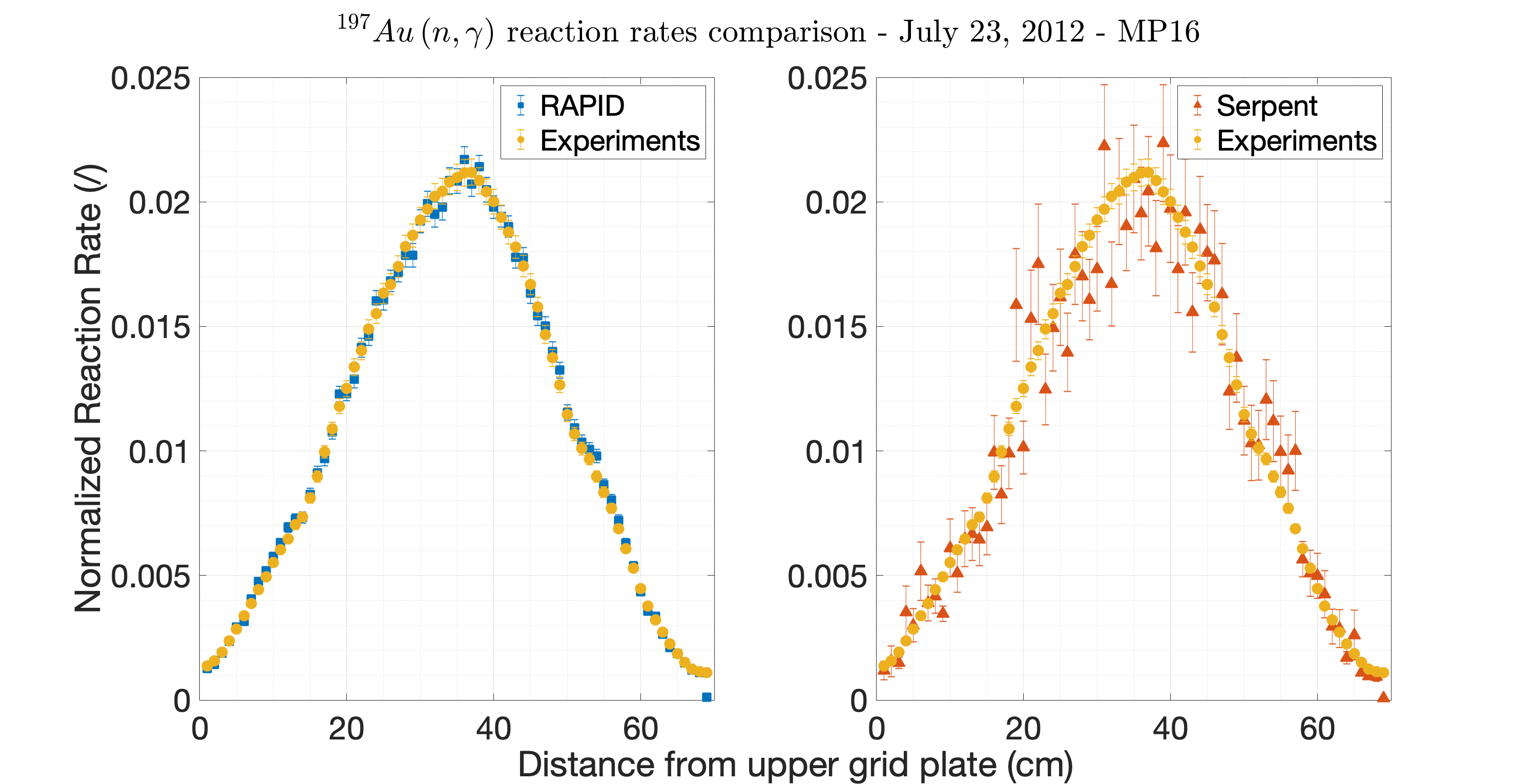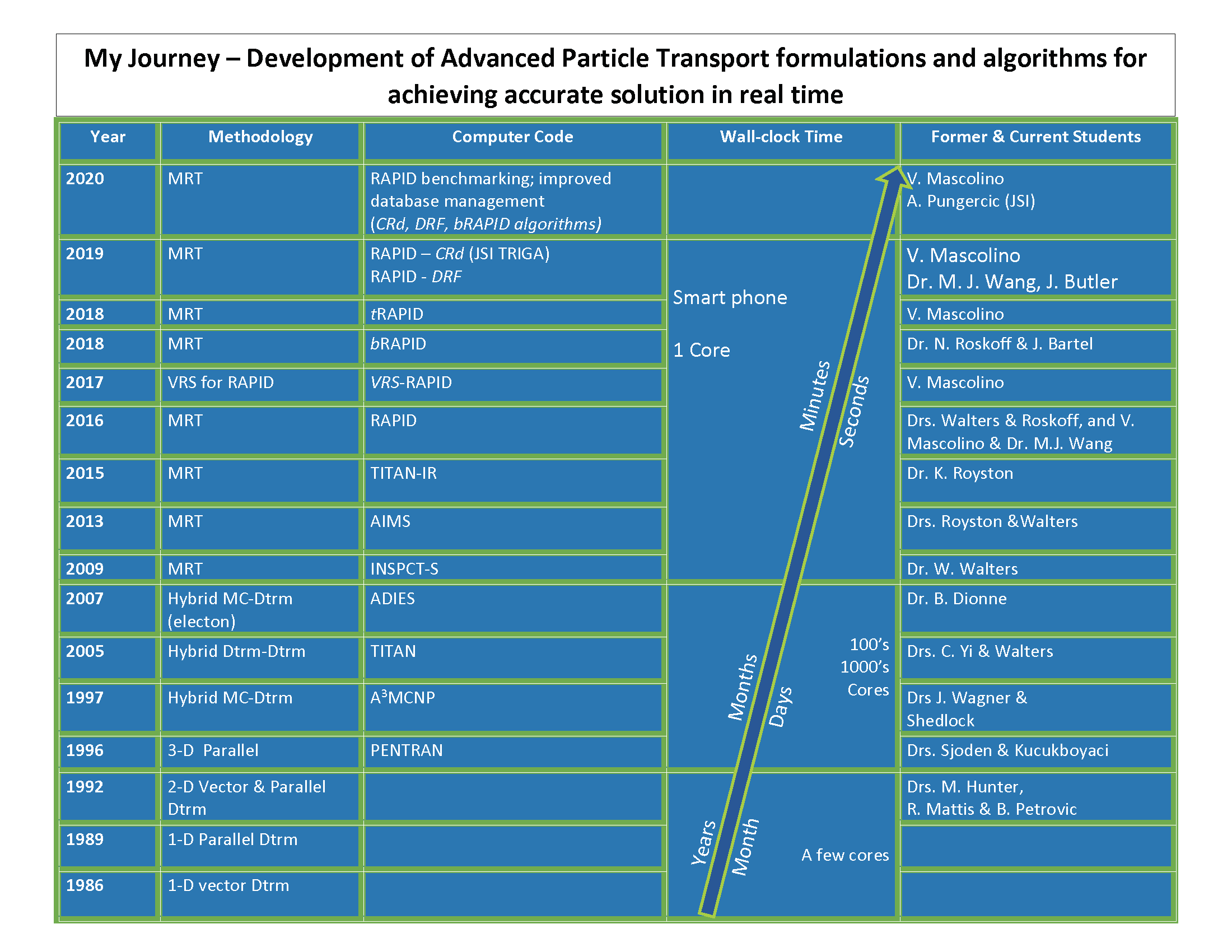Virginia Tech Transport Theory Group (VT3G)
The Virginia Tech Transport Theory Group (VT3G), led by Dr. Alireza Haghighat, is engaged in the development of hybrid, 3-D, multi-scale, parallel particle transport algorithms and codes, and their applications to nuclear energy, nuclear security and non-proliferation and radiation therapy.
In order to make neutronics codes beneficial for design and the operational phases of the nuclear industry, these codes should be accurate and efficient to allow for fast assessment of quantities and real-time analysis of their distributions within a nuclear system. This, however, often comes at the expense of the accuracy of such codes. The recent development of RAPID, however, is a game changer, as it provides detailed solutions in real-time using a single computer core. With its web application, VRS-RAPID, a real-time simulation can be performed on a laptop or smart phone.
The RAPID code system has various applications such as reactor physics, nuclear power plant design, material accountability, particle shielding & detection, nuclear medicine.
CLICK HERE for an overview of 'RAPID Code System,' its capabilities and applications.
Experimental benchmarking of the RAPID code system and its comparison to the Serpent Monte Carlo predictions

Above figures show that RAPID calculated reaction rates of Gold dosimeters positioned axially (within the core of the JSI TRIGA reactor) are in excellent agreement with the measured data. Similar results are achieved by the Serpent Monte Carlo code, but significantly larger uncertainties.
These additional diagrams demonstrate that RAPID results in excellent agreement with experimental data.
Computational time - RAPID vs. Serpent

The above table demonstrate that RAPID yields accurate results in significantly (several orders of magnitude) shorter time than the Serpent code.
Research Topics
Code development
- Multi-stage, Response-function particle Transport (MRT) methodologies (see information on MRT and RAPID)
- Hybrid parallel numerical (Sn, Method of Characteristic, Ray-Tracing & Fictitious Quadrature) particle transport theory methods
- Automated variance reduction techniques for fixed-source and eigenvalue Monte Carlo calculations, e.g., CADIS - Consistent Adjoint Driven Importance Sampling
- Development of advanced particle transport codes: PENTRAN, TITAN, A3MCNP, INSPCT-s, AIMS, TITAN-IR, RAPID.
- Development and benchmarking of new algorithms for the RAPID code-system for: nuclear fuel burnup (bRAPID), MRT-based detector response (DRF-RAPID), and transient particle transport simulations (tRAPID).
- Development of mesh and input generator for PENTRAN and TITAN code system, PENMSHXP
- Development of a collaborative Virtual Reality Systems (VRS) for Scientific Computing.
Applications of modeling and simulation algorithms and codes
- Nuclear power, security and nonproliferation, and medicine
- Advanced reactor core designs (molten salt and solid fuel)
- Reactor physics and shielding
- Image reconstruction in medical devices
- Generation of multigroup nuclear cross sections
- Sensitivity, perturbation methods and uncertainty quantification
MRT Methodology
The VT3G efforts in code and algorithms development and 31-years long know-how has culminated in the establishment of the physics-based Multi-stage Response-function Transport (MRT) methodology. In this methodology, the analysis of a complex nuclear system is partitioned into stages. For each stage, response functions or coefficients are pre-calculated once with a large amount of detail within a range of validity of certain parameters. These coefficients are then coupled by means of a linear system of equations that is solved in real-time, allowing for the calculation of a wide number of different cases within the database validity range.
The Real-time Simulation for Particle Transport and In-situ Detection (RAPID) Code System is based on the MRT methodology. For further information on RAPID please visit the RAPID website.
VT3G Code & Algorithms Timeline
Collaborations
Virginia Tech Centers & Groups
- Collaboration with the ICTAS' Global Energy and Materials Initiative for the establishment of the Multiphysics for Advanced Reactors Simulation (MARS) Center.
- Collaboration with the VT's Center for Neutrino Physics for modeling and optimization of the CHANDLER Detector.
- Collaboration with the ARC Visionarium for the creation of a Virtual Reality System for the code VT3G's code RAPID, known as VRS-RAPID.
Universities and National Labs - Georgia Institute of Technology
- Idaho National Lab
- Idaho State University
- Massachusetts Institute of Technology
- North Carolina State University
- Oak Ridge National Lab
- Ohio State University
- Paul Scherrer Institute, Switzerland
- Politecnico di Torino, Italy
Industry - Framatome
- Holtec International
- Southern Nuclear
- TerraPower
- Westinghouse
